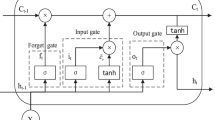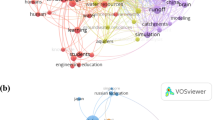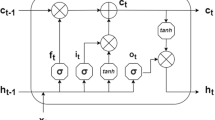Abstract
Water resources matters considerably in maintaining the biological survival and sustainable socio-economic development of a region. Affected by a combination of factors such as geographic characteristics of the basin and climate change, runoff variability is non-linear and non-stationary. Runoff forecasting is one of the important engineering measures to prevent flood disasters. The improvement of its accuracy is also a difficult problem in the research of water resources management. To this end, an ensemble deep learning model was hereby developed to forecast daily river runoff. First, variational mode decomposition (VMD) was used to decompose the original daily runoff series data set into discrete internal model function (IMF) and distinguish signals with different frequencies. Then, for each IMF, a convolutional neural network (CNN) was introduced to extract the features of each IMF component. Subsequently, a bi-directional long short-term memory network (BiLSTM) based on an attention mechanism (AM) was used for prediction. A Bayesian optimization algorithm (BOA) was also introduced to optimize the hyperparameters of the BiLSTM, thereby further improving the estimation precision of the VMD-CNN-AM-BOA-BiLSTM model. The model was applied to the daily runoff data from January 1, 2010 to November 30, 2021 at the Wushan and Weijiabao Hydrological Stations in the Wei River Basin, and the RMSEs of 3.54 and 15.23 were obtained for the test set data at the two stations respectively, which were much better than those of EEMD-VMD-SVM and CNN-BiLSTM-AM models. Additionally, the hereby proposed model is proven to have better peak flood prediction capability and adaptability under different hydrological environments. Based on this sound performance, the model becomes an effective data-driven tool in hydrological forecasting practice, and can also provide some reference and practical application guidance for water resources management and flood warning.





Similar content being viewed by others
Availability of Data and Materials
The data that support the findings of this study are available from the corresponding author upon reasonable request.
References
Ahmed AM, Deo RC, Ghahramani A, Feng Q, Raj N, Yin Z, Yang L (2022) New double decomposition deep learning methods for river water level forecasting. Sci Total Environ 831:154722. https://doi.org/10.1016/j.scitotenv.2022.154722
An L, Hao Y, Yeh TCJ, Liu Y, Liu W, Zhang B (2020) Simulation of karst spring discharge using a combination of time–frequency analysis methods and long short-term memory neural networks. J Hydrol 589:125320. https://doi.org/10.1016/j.jhydrol.2020.125320
Bai Y, Bezak N, Zeng B, Li C, Sapač K, Zhang J (2021) Daily runoff forecasting using a cascade long short-term memory model that considers different variables. Water Resour Manag 35(4):1167–1181. https://doi.org/10.1007/s11269-020-02759-2
Chen G, Tang B, Zeng X, Zhou P, Kang P, Long H (2022) Short-term wind speed forecasting based on long short-term memory and improved BP neural network. Int J Electr Power Energy Syst 134:107365. https://doi.org/10.1016/j.ijepes.2021.107365
Chen S, Ren M, Sun W (2021) Combining two-stage decomposition based machine learning methods for annual runoff forecasting. J Hydrol 603:126945. https://doi.org/10.1016/j.jhydrol.2021.126945
Chen Y, Li J, Wang H, Qin J, Dong L (2017) Large-watershed flood forecasting with high-resolution distributed hydrological model. Hydrol Earth Syst Sci 21(2):735–749. https://doi.org/10.5194/HESS-21-735-2017
Cinar YG, Mirisaee H, Goswami P, Gaussier E, Aït-Bachir A (2018) Period-aware content attention RNNs for time series forecasting with missing values. Neurocomputing 312:177–186. https://doi.org/10.1016/j.neucom.2018.05.090
Damkjaer S, Taylor R (2017) The measurement of water scarcity: Defining a meaningful indicator. Ambio 46(5):513–531. https://doi.org/10.1007/s13280-017-0912-z
Döll P, Douville H, Güntner A, Müller Schmied H, Wada Y (2016) Modelling freshwater resources at the global scale: challenges and prospects. Surv Geophys 37(2):195–221. https://doi.org/10.1007/s10712-015-9343-1
Dragomiretskiy K, Zosso D (2013) Variational mode decomposition. IEEE Trans Signal Process 62(3):531–544. https://doi.org/10.1016/j.sigpro.2020.107610
Fidal J, Kjeldsen TR (2020) Accounting for soil moisture in rainfall-runoff modelling of urban areas. J Hydrol 589:125122. https://doi.org/10.1016/j.jhydrol.2020.125122
Freire PKDMM, Santos CAG, da Silva GBL (2019) Analysis of the use of discrete wavelet transforms coupled with ANN for short-term streamflow forecasting. Appl Soft Comput 80:494–505. https://doi.org/10.1016/j.asoc.2019.04.024
Ghaith M, Siam A, Li Z, El-Dakhakhni W (2020) Hybrid hydrological data-driven approach for daily streamflow forecasting. J Hydrol Eng 25(2):04019063. https://doi.org/10.1061/(ASCE)HE.1943-5584.0001866
Guo N, Wang Z (2022) A combined model based on sparrow search optimized BP neural network and Markov chain for precipitation prediction in Zhengzhou City, China. AQUA—Water Infrastruct Ecosyst Soc 71(6):782–800. https://doi.org/10.2166/aqua.2022.047
Han H, Morrison RR (2021) Data-driven approaches for runoff prediction using distributed data. Stoch Env Res Risk Assess 1–19. https://doi.org/10.1007/s00477-021-01993-3
He X, Luo J, Zuo G, Xie J (2019) Daily runoff forecasting using a hybrid model based on variational mode decomposition and deep neural networks. Water Resour Manag 33(4):1571–1590. https://doi.org/10.1007/s11269-019-2183-x
Hu C, Wu Q, Li H, Jian S, Li N, Lou Z (2018) Deep learning with a long short-term memory networks approach for rainfall-runoff simulation. Water 10(11). https://doi.org/10.3390/w10111543
Jiang L, Chen Y, Wang H (2015) Urban flood simulation based on the SWMM model. Proc Int Assoc Hydrol Sci 368:186–191. https://doi.org/10.5194/piahs-368-186-2015
Kim S, Alizamir M, Kim NW, Kisi O (2020) Bayesian model averaging: A unique model enhancing forecasting accuracy for daily streamflow based on different antecedent time series. Sustainability 12(22):9720. https://doi.org/10.3390/su12229720
Li BJ, Sun GL, Liu Y, Wang WC, Huang XD (2022a) Monthly runoff forecasting using variational mode decomposition coupled with gray wolf optimizer-based long short-term memory neural networks. Water Resour Manag 36(6):2095–2115. https://doi.org/10.1007/s11269-022-03133-0
Li P, Zhang J, Krebs P (2022b) Prediction of flow based on a CNN-LSTM combined deep learning approach. Water 14(6):993. https://doi.org/10.3390/w14060993
Li R, Chang Y, Wang Z (2021) Study of optimal allocation of water resources in Dujiangyan irrigation district of China based on an improved genetic algorithm. Water Supply 21(6):2989–2999. https://doi.org/10.2166/ws.2020.302
Liu W, Wang C, Li Y, Liu Y, Huang K (2021) Ensemble forecasting for product futures prices using variational mode decomposition and artificial neural networks. Chaos Solit Fractals 146:110822. https://doi.org/10.1016/j.chaos.2021.110822
Lu W, Li J, Wang J, Qin L (2021) A CNN-BiLSTM-AM method for stock price prediction. Neural Comput Appl 33(10):4741–4753. https://doi.org/10.1007/s00521-020-05532-z
Niu WJ, Feng ZK, Yang WF, Zhang J (2020) Short-term streamflow time series prediction model by machine learning tool based on data preprocessing technique and swarm intelligence algorithm. Hydrol Sci J 65(15):2590–2603. https://doi.org/10.1080/02626667.2020.1828889
Peng T, Zhang C, Zhou J, Nazir MS (2021) An integrated framework of Bi-directional long-short term memory (BiLSTM) based on sine cosine algorithm for hourly solar radiation forecasting. Energy 221:119887. https://doi.org/10.1016/j.energy.2021.119887
Pérez-Alarcón A, Garcia-Cortes D, Fernández-Alvarez JC, Martínez-González Y (2022) Improving monthly rainfall forecast in a watershed by combining neural networks and autoregressive models. Environ Process 9(3):1–26. https://doi.org/10.1007/s40710-022-00602-x
Pradhan A, Nair AS, Indu J, Kirstetter PE (2021) Impact of sampling of GPM orbital data on streamflow simulations. J Hydrol 593:125798. https://doi.org/10.1016/j.jhydrol.2020.125798
Ren WW, Yang T, Huang CS, Xu CY, Shao QX (2018) Improving monthly streamflow prediction in alpine regions: integrating HBV model with Bayesian neural network. Stoch Env Res Risk Assess 32(12):3381–3396. https://doi.org/10.1007/s00477-018-1553-x
Schmidhuber J (2015) Deep learning in neural networks: An overview. Neural Netw 61:85–117. https://doi.org/10.1016/j.neunet.2014.09.003
Sun J, Wu S, Zhang H, Zhang X, Wang T (2022) Based on multi-algorithm hybrid method to predict the slope safety factor–stacking ensemble learning with bayesian optimization. J Comput Sci 59:101587. https://doi.org/10.1016/j.jocs.2022.101587
Tian Y, Zhang K, Li J, Lin X, Yang B (2018) LSTM-based traffic flow prediction with missing data. Neurocomputing 318:297–305. https://doi.org/10.1016/j.neucom.2018.08.067
UN-Water U (2020) United nations world water development report 2020. Water Clim Change. https://doi.org/10.18356/e2014dcb-en
Viteri López AS, Morales Rodriguez CA (2020) Flash flood forecasting in São Paulo using a binary logistic regression model. Atmosphere 11(5):473. https://doi.org/10.3390/atmos11050473
Wang X, Wang Y, Yuan P, Wang L, Cheng D (2021a) An adaptive daily runoff forecast model using VMD-LSTM-PSO hybrid approach. Hydrol Sci J 66(9):1488–1502. https://doi.org/10.1080/02626667.2021.1937631
Wang Z, Wu X, Wang H, Wu T (2021b) Prediction and analysis of domestic water consumption based on optimized grey and Markov model. Water Supply 21(7):3887–3899. https://doi.org/10.2166/ws.2021.146
Wen L, Li X, Gao L, Zhang Y (2017) A new convolutional neural network-based data-driven fault diagnosis method. IEEE Trans Industr Electron 65(7):5990–5998. https://doi.org/10.1109/TIE.2017.2774777
Wu J, Wang Z, Dong L (2021) Prediction and analysis of water resources demand in Taiyuan City based on principal component analysis and BP neural network. AQUA—Water Infrastruct Ecosyst Soc 70(8):1272–1286. https://doi.org/10.2166/aqua.2021.205
Wu X, Wang Z (2022) Multi-objective optimal allocation of regional water resources based on slime mould algorithm. J Supercomput 78(16):18288–18317. https://doi.org/10.1007/s11227-022-04599-w
Xu Y, Hu C, Wu Q, Jian S, Li Z, Chen Y, Wang S (2022) Research on particle swarm optimization in LSTM neural networks for rainfall-runoff simulation. J Hydrol 608:127553. https://doi.org/10.1016/j.jhydrol.2022.127553
Yang X, Zhou J, Fang W, Wang Y (2020) An ensemble flow forecast method based on autoregressive model and hydrological uncertainty processer. Water 12(11):3138. https://doi.org/10.3390/w12113138
Yu Y, Zhang H, Singh VP (2018) Forward prediction of runoff data in data-scarce basins with an improved ensemble empirical mode decomposition (EEMD) model. Water 10(4):388. https://doi.org/10.3390/w10040388
Yuan X, Chen C, Lei X, Yuan Y, Muhammad Adnan R (2018) Monthly runoff forecasting based on LSTM–ALO model. Stoch Env Res Risk Assess 32(8):2199–2212. https://doi.org/10.1007/s00477-018-1560-y
Zhao X, Chen X, Xu Y, Xi D, Zhang Y, Zheng X (2017) An EMD-based chaotic least squares support vector machine hybrid model for annual runoff forecasting. Water 9(3):153. https://doi.org/10.3390/w9030153
Zuo G, Luo J, Wang N, Lian Y, He X (2020) Decomposition ensemble model based on variational mode decomposition and long short-term memory for streamflow forecasting. J Hydrol 585:124776. https://doi.org/10.1016/j.jhydrol.2020.124776
Funding
It was supported by the Open Research Fund of State Key Laboratory of Simulation and Regulation of Water Cycle in River Basin, China Institute of Water Resources and Hydropower Research (grant No. IWHR-SKL-201905).
Author information
Authors and Affiliations
Contributions
Junhao Wu: Conceptualization, Writing—original draft, Methodology, Investigation, Visualization, Validation. Zhaocai Wang: Methodology, Investigation, Validation, Supervision, Writing-review. Yuan Hu: Writing—original draft, Investigation. Tao Sen: Investigation, Visualization. Jinghan Dong: Writing—original draft.
Corresponding author
Ethics declarations
Ethical Approval
Not applicable.
Consent to Participate
Not applicable.
Consent to Publish
Not applicable.
Conflicts of Interest
The authors declare that they have no known competing financial interests.
Additional information
Publisher's Note
Springer Nature remains neutral with regard to jurisdictional claims in published maps and institutional affiliations.
Supplementary Information
Below is the link to the electronic supplementary material.
Rights and permissions
Springer Nature or its licensor (e.g. a society or other partner) holds exclusive rights to this article under a publishing agreement with the author(s) or other rightsholder(s); author self-archiving of the accepted manuscript version of this article is solely governed by the terms of such publishing agreement and applicable law.
About this article
Cite this article
Wu, J., Wang, Z., Hu, Y. et al. Runoff Forecasting using Convolutional Neural Networks and optimized Bi-directional Long Short-term Memory. Water Resour Manage 37, 937–953 (2023). https://doi.org/10.1007/s11269-022-03414-8
Received:
Accepted:
Published:
Issue Date:
DOI: https://doi.org/10.1007/s11269-022-03414-8




